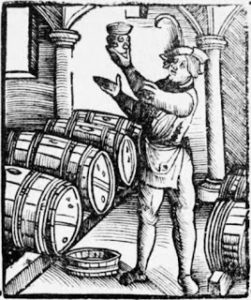 People don’t give municipal records the respect they deserve. Where the rubber hits the road, that’s what a municipality is. Consider this from the Records of the Borough of Leicester Being a Series of Extracts from the Archives of the Corporation of Leicester, 1509-1603:
People don’t give municipal records the respect they deserve. Where the rubber hits the road, that’s what a municipality is. Consider this from the Records of the Borough of Leicester Being a Series of Extracts from the Archives of the Corporation of Leicester, 1509-1603:
Aile tasters and sworne men within the towne of Leicester aforesaid to make inquiries there of the defaltes of tunners & typplers and especially to inquire and present the defaltes and trespaces of common dronckerdes that do vse to sitt typplynge at the aile houses all daye and all nyghte vnthryftely, and their wyves and children almost sterve at home for lacke of good releffe and sustentacion.
That cheery wee note from the Tudor world was entered into the records on November 18, 1569. Another dated April 7, 1592 just states “Ale 2\d. a gallon “as well strong ale as the tunner’s ale.” What’s a tunner? Or tunner’s ale? In the records of the municipal corporation of Boston, there may be a bit more information:
According to the Corporate records, the brewers in 1547 were ordered to sell good ale for 1¼d the gallon, double beer 1½d. the gallon, and single beer 1d. the gallon. In 1552 small ale was sold at three gallons for a penny, “till malt rise in price;” and good ale 2d. the gallon. In 1558 the brewers were to sell double beer at 20d. the firkin, and single beer for 10d. In 1575 certain persons were appointed ale-tunners to taste the ale and beer before it was sold. Brewers, before they “tunne their ale and beer, to send for the ale-tunners to taste the same to see that it is good wholesome drink:” prices to be regulated according to the price of malt.
That doesn’t look right. Muddies whether the ale tunner is an officer who is required to ensure that the beer is in good order or if they are someone who needs ordering about by an officer. The tunner seems to be consistently defined elsewhere as the cask filler, not the judge of anything. Hmm. This record from Nov. 16, 1520 also from Leicester helps a bit with the process:
Allso that no brewer within this towne sell forthe no ale tyll the allderman of that ward and too of ye XLVIll haue tasted their alls bothe the best and ye second in pene of forfeture the fyrst tyme iiij”. Wnd. and so to dowbyll as ofte as they make defawte; and yf the alderman of the ward be a brewer hymselfe or thos that [are] of the XLVIII, then to call the alderman of ye next ward to taste as aboweseyd for they that be brewers schallbe no tasters.
I love that “best and ye second” as the same was still going on in Vassar’s brewery in 1808 before things got too scientific. And there are a string of separate Tudor functions and trades all in those passages up there: the XLVIII, aldermen, brewers, tunners, typlers, tasters. The XLVIII or “the 48” appear to be members of a secondary level municipal council, beneath the one formed by the aldermen. A typler is a retailer as we can see the Leicester’s law of around that time provided “that no typler within this towne sell no ale with onlawfull mesures.”¹ It looks like the tunners and the typlers answer to the alderman and the tasters all to ensure thedronckerdes get their proper aile. If the aldermen and tasters are checking on on the tunners and typlers, they may be ensuring proper measures are sold at both the wholesale and retail levels and not just whether the stuff is foul or tasty. Quantity as well as quality control. Tasters were municipal officers who were otherwise titled better known as “ale conners” and lesser known as “ale founders” – the last of which lingers on as an especially obscure family last name. They also confirmed price. In 1853, of the 234 boroughs in England and Wales, 26 had officers titled “ale tasters”, six had an “ale founder” while only four officers were called “ale conners”. Martyn has explained that they did not sit in puddles of ale as part of their job despite modern sillinesses. Hornsey has more of both the law and the silly.
If all that is correct, the note about Boston is wrong and the tunner is not the taster as these were separate and separated tasks. Checks and balances. Still not sure what “tunner’s ale” was in 1500s Leicester… or any other place or time for that matter. Another day for that perhaps.
¹The named measures include “strykes”, gallons, “potell”, quarts, pintes. I can spot the pottle but not sure what a stryke is. By the way, I am not sure if that image is related to ale, is English or even from the 1500s. Looks swell, though.
